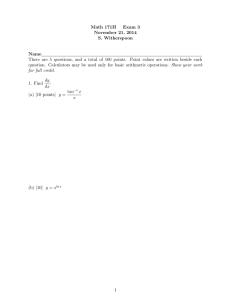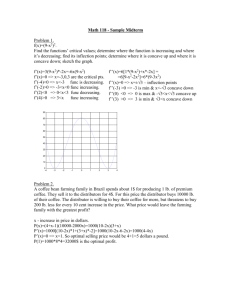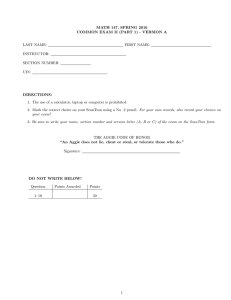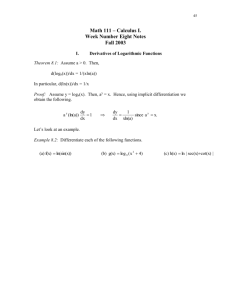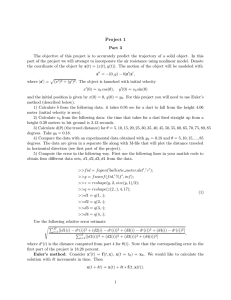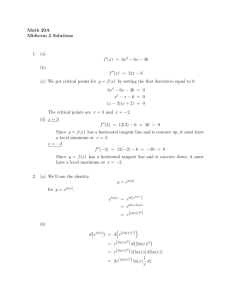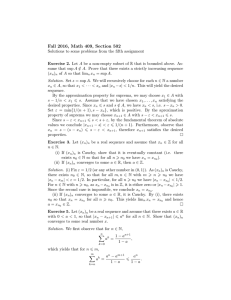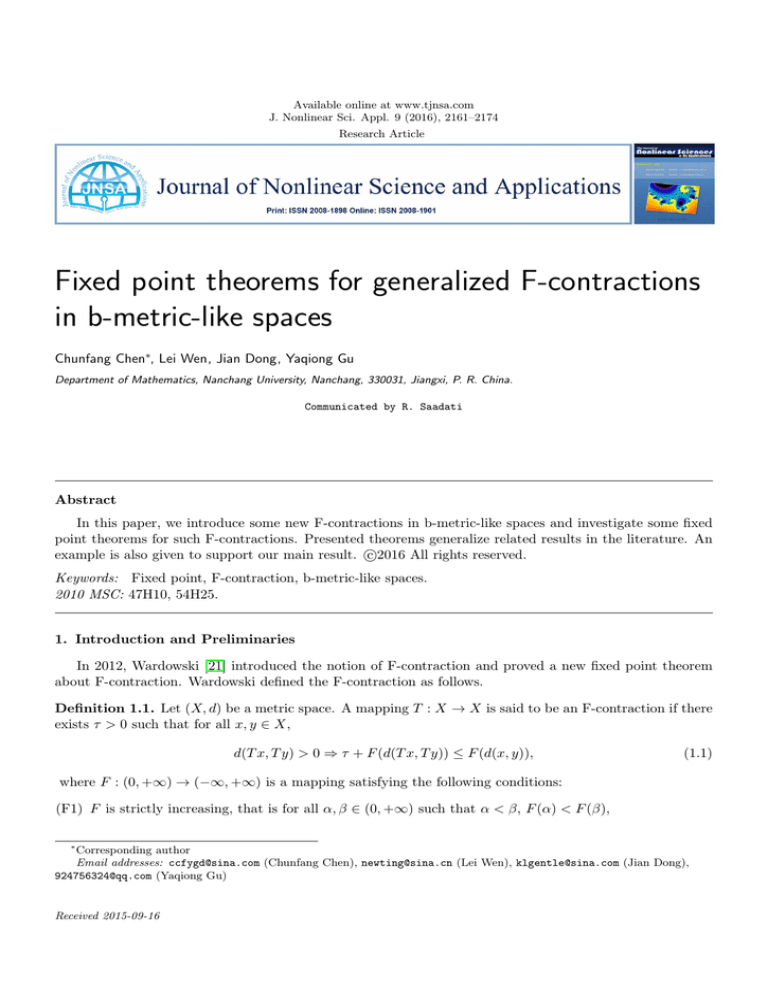
Available online at www.tjnsa.com
J. Nonlinear Sci. Appl. 9 (2016), 2161–2174
Research Article
Fixed point theorems for generalized F-contractions
in b-metric-like spaces
Chunfang Chen∗, Lei Wen, Jian Dong, Yaqiong Gu
Department of Mathematics, Nanchang University, Nanchang, 330031, Jiangxi, P. R. China.
Communicated by R. Saadati
Abstract
In this paper, we introduce some new F-contractions in b-metric-like spaces and investigate some fixed
point theorems for such F-contractions. Presented theorems generalize related results in the literature. An
c
example is also given to support our main result. 2016
All rights reserved.
Keywords: Fixed point, F-contraction, b-metric-like spaces.
2010 MSC: 47H10, 54H25.
1. Introduction and Preliminaries
In 2012, Wardowski [21] introduced the notion of F-contraction and proved a new fixed point theorem
about F-contraction. Wardowski defined the F-contraction as follows.
Definition 1.1. Let (X, d) be a metric space. A mapping T : X → X is said to be an F-contraction if there
exists τ > 0 such that for all x, y ∈ X,
d(T x, T y) > 0 ⇒ τ + F (d(T x, T y)) ≤ F (d(x, y)),
(1.1)
where F : (0, +∞) → (−∞, +∞) is a mapping satisfying the following conditions:
(F1) F is strictly increasing, that is for all α, β ∈ (0, +∞) such that α < β, F (α) < F (β),
∗
Corresponding author
Email addresses: ccfygd@sina.com (Chunfang Chen), newting@sina.cn (Lei Wen), klgentle@sina.com (Jian Dong),
924756324@qq.com (Yaqiong Gu)
Received 2015-09-16
C. Chen, L. Wen, J. Dong, Y. Gu, J. Nonlinear Sci. Appl. 9 (2016), 2161–2174
2162
(F2) for any sequence {αn } of positive real numbers, the following holds:
lim αn = 0 if and only if
n→+∞
lim F (αn ) = −∞,
n→+∞
(F3) there exists k ∈ (0, 1) such that lim αk F (α) = 0.
α→0+
After that, F-contraction was generalized and many fixed point theorems concerning F-contraction were
investigated [3, 5, 6, 11, 16, 19].
On the other hand, the concept of metric spaces has been generalized by many authors, such as partial
metric spaces [18], b-metric spaces [12], metric-like spaces [7], partial b-metric spaces [20], quasi-partial
metric spaces [15] and b-dislocated metric spaces [13] were introduced and many results in these spaces were
obtained [1, 2, 8, 10, 14, 16, 17]. Recently, the notion of b-metric-like spaces were introduced by Alghamdi
[4] and some fixed point theorems were studied in such spaces [4, 9].
The aim of this paper is to introduce some new generalized type of F-contractions and prove some fixed
point theorems about such new F-contractions in b-metric-like spaces. Our results generalize and improve
related results in the literature. An example is presented to support our main result. Throughout this
+
paper, the letters N, N+ , R, R+
0 and R will denote the set of all nonnegative integer numbers, the set of
all positive integer numbers, the set of all real numbers, the set of all nonnegative real numbers and the set
of all positive real numbers, respectively.
Let us recall some definitions and facts about partial metric spaces and b-metric-like spaces.
Definition 1.2 ([18]). A partial metric on a nonempty set X is a function p : X × X → R+
0 such that for
all x, y, z ∈ X:
(P1 ) x = y ⇔ p(x, y) = p(x, x) = p(y, y),
(P2 ) p(x, x) ≤ p(x, y),
(P3 ) p(x, y) = p(y, x),
(P4 ) p(x, y) ≤ p(x, z) + p(z, y) − p(z, z).
A partial metric space is a pair (X, p) such that X is a nonempty set and p is a partial metric on X. It
is clear that, if p(x, y) = 0, then from (P1 ) and (P2 ), x = y. But if x = y, p(x, y) may not be 0.
In a partial metric space, the concepts of convergence, completeness and continuity are defined as follows.
Definition 1.3 ([18]). Let (X, p) be a partial metric space. Then:
(i) A sequence {xn } in a partial metric space (X, p) converges to a point x ∈ X if and only if p(x, x) =
lim p(x, xn ).
n→+∞
(ii) A sequence {xn } in a partial metric space (X, p) is called a Cauchy sequence if there exists (and is
finite) lim p(xm , xn ).
n,m→+∞
Definition 1.4 ([4]). A b-metric-like on a nonempty set X is a function σ : X × X → R+
0 such that for all
x, y, z ∈ X and a constant s ≥ 1, the following three conditions hold true:
(σ1 ) if σ(x, y) = 0 then x = y;
(σ2 ) σ(x, y) = σ(y, x);
(σ3 ) σ(x, z) ≤ s(σ(x, y) + σ(y, z)).
The pair (x, σ) is then called a b-metric-like space.
Example 1.5 ([9]). Let X = {0, 1, 2} and let
σ(x, y) =
2, x = y = 0,
1
2 , otherwise.
Then (X, σ) is a b-metric-like space with the constant s = 2.
In [4], some concepts in b-metric-like spaces were introduced.
C. Chen, L. Wen, J. Dong, Y. Gu, J. Nonlinear Sci. Appl. 9 (2016), 2161–2174
2163
Each b-metric-like σ on X generalizes a topology τσ on X whose base is the family of open σ-balls
Bσ (x, ε) = {y ∈ X : |σ(x, y) − σ(x, x)| < ε} for all x ∈ X and ε > 0.
A sequence {xn } in the b-metric-like space (X, σ) converges to a point x ∈ X if and only if σ(x, x) =
lim σ(x, xn ).
n→+∞
A sequence {xn } in the b-metric-like space (X, σ) is called a Cauchy sequence if there exists (and is
finite) lim σ(xm , xn ).
n,m→+∞
A b-metric-like space is called complete if every Cauchy sequence {xn } in X converges with respect to
τσ to a point x ∈ X such that lim σ(x, xn ) = σ(x, x) = lim σ(xm , xn ).
n→+∞
n,m→+∞
Definition 1.6. Suppose that (X, σ) is a b-metric-like space. A mapping T : X → X is said to be
continuous at x ∈ X, if for every ε > 0 there exists δ > 0 such that T (Bσ (x, δ)) ⊆ Bσ (T x, ε)). We say that
T is continuous on X if T is continuous at all x ∈ X.
Remark 1.7 ([9]). Let (X, σ) be a b-metric-like space and let f : X → X be a continuous mapping. Then
lim σ(xn , x) = σ(x, x) ⇒ lim σ(f xn , f x) = σ(f x, f x).
n→+∞
n→+∞
2. Main results
In this section, we will introduce some generalized F-contractions and investigate some fixed point
theorems for such generalized F-contractions. We begin with the following definitions.
Definition 2.1. Let F be the family of all functions F : R+ → R such that
(F1) F is strictly increasing, that is, for all α, β ∈ R+ such that α < β, F (α) < F (β),
(F2) for any sequence {αn } of positive real numbers, the following holds:
lim αn = 0 if and only if
n→+∞
lim F (αn ) = −∞.
n→+∞
Definition 2.2. Let (X, σ) be a b-metric-like space. A self-mapping T : X −→ X is said to be a generalized
F-contraction of type (I) if there exist τ > 0 and F ∈ F such that
1
σ(x, T x) < σ(x, y) ⇒
2s
τ + F (σ(T x, T y)) ≤αF (σ(x, y)) + βF (σ(x, T x)) + γF (σ(y, T y)) + tF (
+ hF (
σ(x, T y)
)
2s
(2.1)
σ(y, T x)
)
2s
for all x, y ∈ X with σ(T x, T y) > 0, where α, β, γ, h, t ∈ [0, 1] such that α+β +γ +h+t = 1 and 1−t−γ > 0.
Theorem 2.3. Let (X, σ) be a complete b-metric-like space and T a generalized F-contraction of type (I).
Then, T has a fixed point v ∈ X; that is, T v = v.
Proof. Let x0 be an arbitrary point in X. Set T x0 = x1 and T x1 = x2 . Continuing this process, we can
construct sequence {xn } in X such that
xn+1 = T xn , n ∈ N.
(2.2)
If there exists n0 ∈ N such that σ(xn0 , xn0 +1 ) = 0, then xn0 is the fixed point of T which completes the
proof. Consequently, we suppose σ(xn , xn+1 ) > 0 for all n ∈ N. Hence, we have
1
σ(xn , T xn ) < σ(xn , T xn ) ∀n ∈ N.
2s
(2.3)
C. Chen, L. Wen, J. Dong, Y. Gu, J. Nonlinear Sci. Appl. 9 (2016), 2161–2174
2164
By (2.1), we get
τ + F (σ(T xn , T 2 xn )) ≤αF (σ(xn , T xn )) + βF (σ(xn , T xn )) + γF (σ(T xn , T 2 xn ))
+ tF (
σ(xn , T 2 xn )
σ(T xn , T xn )
) + hF (
) ∀n ∈ N.
2s
2s
(2.4)
Now, we prove the following inequality:
σ(xn+1 , T xn+1 ) < σ(xn , T xn ) ∀n ∈ N.
(2.5)
Suppose, on the contrary, that there exists n0 ∈ N such that σ(xn0 +1 , T xn0 +1 ) ≥ σ(xn0 , T xn0 ), due to (2.4),
we have
τ + F (σ(T xn0 , T 2 xn0 )) ≤αF (σ(xn0 , T xn0 )) + βF (σ(xn0 , T xn0 )) + γF (σ(T xn0 , T 2 xn0 ))
σ(xn0 , T 2 xn0 )
σ(T xn0 , T xn0 )
) + hF (
)
2s
2s
≤αF (σ(xn0 , T xn0 )) + βF (σ(xn0 , T xn0 )) + γF (σ(T xn0 , T 2 xn0 ))
+ tF (
sσ(xn0 , T xn0 ) + sσ(T xn0 , T 2 xn0 )
2sσ(T xn0 , xn0 )
) + hF (
)
2s
2s
≤αF (σ(xn0 , T xn0 )) + βF (σ(xn0 , T xn0 )) + γF (σ(T xn0 , T 2 xn0 ))
+ tF (
+ tF (σ(T xn0 , T 2 xn0 )) + hF (σ(T xn0 , xn0 )),
which yields
τ + (1 − γ − t)F (σ(T xn0 , T 2 xn0 )) ≤ (α + β + h)F (σ(T xn0 , xn0 )),
that is,
F (σ(T xn0 , T 2 xn0 )) ≤ F (σ(T xn0 , xn0 )) −
τ
,
1−γ−t
which together with (F1) implies σ(T xn0 , T 2 xn0 ) < σ(T xn0 , xn0 ), that is, σ(xn0 +1 , T xn0 +1 ) < σ(T xn0 , xn0 ).
It is a contradiction with σ(xn0 +1 , T xn0 +1 ) ≥ σ(xn0 , T xn0 ), so (2.5) holds. Therefore, {σ(xn , T xn )} is a
decreasing sequence of real numbers which is bounded from below. Suppose that there exists A ≥ 0 such
that
lim σ(xn , T xn ) = A = inf {σ(xn , T xn ) : n ∈ N}.
n→+∞
(2.6)
Now, we show A = 0. Suppose, on the contrary, that A > 0. For every ε > 0, there exists m ∈ N such that
σ(xm , T xm ) < A + ε.
(2.7)
F (σ(xm , T xm )) < F (A + ε).
(2.8)
1
σ(xm , T xm ) < σ(xm , T xm ).
2s
(2.9)
By F(1), we have
From (2.3), we have
Since T is a generalized F-contraction of type (I), we get
τ + F (σ(T xm , T 2 xm )) ≤αF (σ(xm , T xm )) + βF (σ(xm , T xm )) + γF (σ(T xm , T 2 xm ))
+ tF (
σ(xm , T 2 xm )
σ(T xm , T xm )
) + hF (
)
2s
2s
C. Chen, L. Wen, J. Dong, Y. Gu, J. Nonlinear Sci. Appl. 9 (2016), 2161–2174
2165
≤αF (σ(xm , T xm )) + βF (σ(xm , T xm )) + γF (σ(T xm , T 2 xm ))
sσ(xm , T xm ) + sσ(T xm , T 2 xm )
2sσ(T xm , xm )
) + hF (
)
2s
2s
≤αF (σ(xm , T xm )) + βF (σ(xm , T xm )) + γF (σ(T xm , T 2 xm ))
+ tF (
+ tF (σ(xm , T xm )) + hF (σ(T xm , xm )),
which implies
(1 − γ)F (σ(T xm , T 2 xm )) ≤ (α + β + t + h)F (σ(xm , T xm )) − τ.
(2.10)
Taking α + β + γ + h + t = 1 into account, we get, by (2.10),
F (σ(T xm , T 2 xm )) ≤ F (σ(xm , T xm )) −
Since
1
2
2s σ(T xm , T xm )
τ
.
1−γ
(2.11)
< σ(T xm , T 2 xm ), from (2.1) we have
τ + F (σ(T 2 xm , T 3 xm )) ≤αF (σ(T xm , T 2 xm )) + βF (σ(T xm , T 2 xm )) + γF (σ(T 2 xm , T 3 xm ))
σ(T xm , T 3 xm )
σ(T 2 xm , T 2 xm )
) + hF (
)
2s
2s
≤αF (σ(T xm , T 2 xm )) + βF (σ(T xm , T 2 xm )) + γF (σ(T 2 xm , T 3 xm ))
+ tF (
sσ(T xm , T 2 xm ) + sσ(T 2 xm , T 3 xm )
2sσ(T 2 xm , T xm )
) + hF (
)
2s
2s
≤αF (σ(T xm , T 2 xm )) + βF (σ(T xm , T 2 xm )) + γF (σ(T 2 xm , T 3 xm ))
+ tF (
+ tF (σ(T xm , T 2 xm )) + hF (σ(T 2 xm , T xm )).
This yields
F (σ(T 2 xm , T 3 xm )) ≤ F (σ(T xm , T 2 xm )) −
τ
.
1−γ
Continuing the above process and taking (2.8) into account, we have
τ
1−γ
2τ
≤F (σ(T n−2 xm , T n−1 xm )) −
1−γ
..
.
nτ
≤σ(xm , T xm )) −
1−γ
nτ
<F (A + ε) −
.
1−γ
F (σ(T n xm , T n+1 xm )) ≤F (σ(T n−1 xm , T n xm )) −
Letting n → +∞ in (2.12), we get
(2.12)
lim F (σ(T n xm , T n+1 xm )) = −∞ which together with F(2) implies
n→+∞
lim σ(T n xm , T n+1 xm ) = 0. So, there exists N1 ∈ N such that σ(T n xm , T n+1 xm ) < A for all n > N1 , that
n→+∞
is, σ(xm+n , T xm+n ) < A for all n > N1 , which is a contradiction with the definition of A, therefore,
lim σ(xn , T xn ) = 0.
(2.13)
lim
(2.14)
n→+∞
Now, we prove
n,m→+∞
σ(xn , xm ) = 0.
C. Chen, L. Wen, J. Dong, Y. Gu, J. Nonlinear Sci. Appl. 9 (2016), 2161–2174
2166
Suppose, on the contrary, that there exists ε > 0 and sequences {p(n)} and {q(n)} of natural numbers such
that
p(n) > q(n) > n, σ(xp(n) , xq(n) ) ≥ ε and σ(xp(n)−1 , xq(n) ) < ε ∀n ∈ N.
(2.15)
Applying the triangle inequality, we get
σ(xp(n) , xq(n) ) ≤sσ(xp(n) , xp(n)−1 ) + sσ(xp(n)−1 , xq(n) )
<sσ(xp(n) , xp(n)−1 ) + sε
(2.16)
=sσ(T xp(n)−1 , xp(n)−1 ) + sε ∀n ∈ N.
Owing to (2.13), there exists N2 ∈ N such that
σ(xp(n)−1 , T xp(n)−1 ) < ε, σ(xp(n) , T xp(n) ) < ε, σ(xq(n) , T xq(n) ) < ε ∀n > N2 ,
(2.17)
which together with (2.16) shows
σ(xp(n) , xq(n) ) < 2sε ∀n > N2 ,
(2.18)
F (σ(xp(n) , xq(n) )) < F (2sε) ∀n > N2 .
(2.19)
ε
1
σ(xp(n) , T xp(n) ) <
< σ(xp(n) , xq(n) ) ∀n > N2 .
2s
2s
(2.20)
hence
From (2.15) and (2.17), we get
Using the triangle inequality, we have
ε ≤ σ(xp(n) , xp(n) ) ≤ sσ(xp(n) , xp(n)+1 ) + s2 σ(xp(n)+1 , xq(n)+1 ) + s2 σ(xq(n)+1 , xq(n) ).
Letting n → +∞ in (2.21), by (2.13), we obtain
ε
s2
(2.21)
≤ lim inf σ(xp(n)+1 , xq(n)+1 ), hence, there exists N3 ∈ N,
n→+∞
such that σ(xp(n)+1 , xq(n)+1 ) > 0 for n > N3 , that is σ(T xp(n) , T xq(n) ) > 0 for n > N3 . By (2.1) and (2.19),
we have
τ + F (σ(T xp(n) , T xq(n) )) ≤αF (σ(xp(n) , xq(n) )) + βF (σ(xp(n) , T xp(n) )) + γF (σ(xq(n) , T xq(n) ))
σ(xp(n) , T xq(n) )
σ(xq(n) , T xp(n) )
) + hF (
)
2s
2s
≤αF (σ(xp(n) , xq(n) )) + βF (σ(xp(n) , T xp(n) )) + γF (σ(xq(n) , T xq(n) ))
+ tF (
(2.22)
σ(xp(n) , xq(n) ) + σ(xq(n) , T xq(n) )
+ tF (
)
2
σ(xq(n) , xp(n) ) + σ(xp(n) , T xp(n) )
+ hF (
)
2
for n > max{N2 , N3 }.
Taking (2.17), (2.18) and (2.19) into account, (2.22) yields
τ + F (σ(T xp(n) , T xq(n) ) <αF (2sε) + βF (σ(xp(n) , T xp(n) )) + γF (σ(xq(n) , T xq(n) ))
2sε + ε
2sε + ε
+ tF (
) + hF (
)
2
2
for n > max{N2 , N3 }.
(2.23)
C. Chen, L. Wen, J. Dong, Y. Gu, J. Nonlinear Sci. Appl. 9 (2016), 2161–2174
2167
Letting n → +∞ in (2.23), we obtain
lim F (σ(T xp(n) , T xq(n) )) = −∞,
n→+∞
which yields lim σ(T xp(n) , T xq(n) ) = 0, which together with
n→+∞
σ(xp(n) , xq(n) ) ≤ sσ(xp(n) , xp(n)+1 ) + s2 σ(xp(n)+1 , xq(n)+1 ) + s2 σ(xq(n)+1 , xq(n) )
shows
lim σ(xp(n) , xq(n) ) = 0, this is a contradiction with (2.15), so (2.14) holds, therefore, {xn } is a
n→+∞
Cauchy sequence in X. Since (X, σ) is complete, there exists v ∈ X such that
σ(v, v) = lim σ(xn , v) =
n→+∞
lim
n,m→+∞
σ(xn , xm ) = 0.
(2.24)
It is easy to prove that the following fact holds,
σ(xn , T xn )
σ(T xn , T 2 xn )
< σ(xn , v) or
< σ(T xn , v).
2s
2s
(2.25)
Suppose, on the contrary, that there exists m0 ∈ N such that
σ(xm0 , T xm0 )
σ(T xm0 , T 2 xm0 )
≥ σ(xm0 , v) and
≥ σ(T xm0 , v).
2s
2s
(2.26)
By (2.5) and (2.26), we get
σ(xm0 , T xm0 ) ≤sσ(xm0 , v) + sσ(v, T xm0 )
σ(xm0 , T xm0 ) σ(T xm0 , T 2 xm0 )
+
2
2
σ(xm0 , T xm0 ) σ(xm0 , T xm0 )
+
<
2
2
=σ(xm0 , T xm0 ).
≤
This is a contradiction. Hence (2.25) holds and it yields
τ + F (σ(T xn , T v)) ≤αF (σ(xn , v)) + βF (σ(xn , T xn )) + γF (σ(v, T v)) + tF (
σ(xn , T v)
)
2s
σ(v, T xn )
+ hF (
),
2s
(2.27)
or
τ + F (σ(T 2 xn , T v)) ≤αF (σ(T xn , v)) + βF (σ(T xn , T 2 xn )) + γF (σ(v, T v))
+ tF (
σ(v, T 2 xn )
σ(T xn , T v)
) + hF (
).
2s
2s
(2.28)
Next, we discuss the following cases.
Case 1: Suppose that (2.27) holds. From (2.27), we have
τ + F (σ(T xn , T v)) ≤αF (σ(xn , v)) + βF (σ(xn , T xn )) + γF (σ(v, T v))
σ(xn , v) + σ(v, T v)
σ(v, xn ) + σ(xn , T xn )
+ tF (
) + hF (
).
2
2
(2.29)
Owing to (2.13) and (2.24), for some ε0 > 0, there exists N4 ∈ N such that
σ(v, xn ) < ε0 and σ(xn , T xn ) < ε0 ,
(2.30)
C. Chen, L. Wen, J. Dong, Y. Gu, J. Nonlinear Sci. Appl. 9 (2016), 2161–2174
2168
for N > N4 .
With the help of (2.29) and (2.30), we get
τ + F (σ(T xn , T v)) ≤ αF (σ(xn , v)) + βF (σ(xn , T xn )) + γF (σ(v, T v)) + tF (
ε0 + σ(v, T v)
) + hF (ε0 )
2
for N > N4 .
Taking n → +∞ in the above inequality, we have lim F (σ(T xn , T v)) = −∞ which yields
n→+∞
lim σ(T xn , T v) = 0.
(2.31)
n→+∞
On the other hand, we have σ(v, T v) ≤ sσ(v, T xn ) + sσ(T xn , T v) = sσ(v, xn+1 ) + sσ(T xn , T v). By
letting n → +∞ in the above inequality, by (2.24) and (2.31), we get σ(v, T v) = 0, it means v = T v. Thus
v is the fixed point of T .
Case 2: Let (2.28) hold. From (2.28), we have
F (σ(T 2 xn , T v)) <τ + F (σ(T 2 xn , T v))
≤αF (σ(T xn , v)) + βF (σ(T xn , T 2 xn )) + γF (σ(v, T v)) + tF (
+ hF (
σ(T xn , T v)
)
2s
σ(v, T 2 xn )
)
2s
≤αF (σ(T xn , v)) + βF (σ(T xn , T 2 xn )) + γF (σ(v, T v)) + tF (
σ(T xn , v) + σ(v, T v)
) (2.32)
2
σ(v, T xn ) + σ(T xn , T 2 xn )
)
2
=αF (σ(xn+1 , v)) + βF (σ(xn+1 , T xn+1 )) + γF (σ(v, T v))
σ(v, xn+1 ) + σ(xn+1 , T xn+1 )
σ(xn+1 , v) + σ(v, T v)
) + hF (
).
+ tF (
2
2
+ hF (
(2.30) and (2.32) yield
F (σ(T 2 xn , T v)) <αF (σ(xn+1 , v)) + βF (σ(xn+1 , T xn+1 )) + γF (σ(v, T v))
ε0 + σ(v, T v)
+ tF (
) + hF (ε0 )
2
(2.33)
for N > N4 .
Taking n → +∞ in (2.33), we have lim F (σ(T 2 xn , T v)) = −∞ which yields
n→+∞
lim σ(T 2 xn , T v) = 0.
n→+∞
(2.34)
On the other hand, we have σ(v, T v) ≤ sσ(v, T 2 xn ) + sσ(T 2 xn , T v) = sσ(v, xn+2 ) + sσ(T 2 xn , T v). By
letting n → +∞ in the above inequality, from (2.24) and (2.34), we get σ(v, T v) = 0, it means v = T v.
Thus v is the fixed point of T and this completes the proof.
Definition 2.4. Let (X, σ) be a b-metric-like space. A self-mapping T : X −→ X is said to be a generalized
F-contraction of type (II) if there exist τ > 0 and F ∈ F such that
1
σ(x, T x) < σ(x, y) ⇒ τ + F (σ(T x, T y)) ≤ αF (σ(x, y)) + βF (σ(x, T x)) + γF (σ(y, T y))
2s
for all x, y ∈ X with σ(T x, T y) > 0, where γ ∈ [0, 1) and α, β ∈ [0, 1] such that α + β + γ = 1.
By taking t = h = 0 in Theorem 2.3, we can get the following corollary.
C. Chen, L. Wen, J. Dong, Y. Gu, J. Nonlinear Sci. Appl. 9 (2016), 2161–2174
2169
Corollary 2.5. Let (X, σ) be a complete b-metric-like space and T a generalized F-contraction of type (II).
Then, T has a fixed point v ∈ X; that is, T v = v.
Remark 2.6. Replacing b-metric-like space by b-metric space in Corollary 2.5, we can get Theorem 9 in [5].
Corollary 2.7. Let (X, σ) be a complete b-metric-like space and T a self-mapping on X. Assume that there
exist τ > 0 and F ∈ F such that, for all x, y ∈ X with σ(T x, T y) > 0,
1
σ(x, T x) < σ(x, y) ⇒ τ + F (σ(T x, T y)) ≤ F (σ(x, y)).
2s
Then, T has a fixed point v ∈ X; that is, T v = v.
Proof. The proof is easy by taking α = 1, β = γ = 0 in Corollary 2.5.
Corollary 2.8. Let (X, σ) be a complete partial space and T a generalized F-contraction of type (I). Then,
T has a unique fixed point.
Proof. Since every partial metric space is a b-metric-like space [4], the existence of fixed point of the
mapping T is guaranteed by Theorem 2.3. Now, we prove the uniqueness of the fixed point of mapping
T . Suppose u, v are fixed point of T such that u 6= v, then we get p(u, v) > 0. If p(v, v) = 0, then
p(v,T v)
v)
0 = p(v,v)
< p(v, u). If p(v, v) > 0, then 0 = p(v,T
= p(v,v)
2s =
2s
2s
2s < p(v, v) ≤ p(v, u), hence we have
τ + F (p(v, u)) =τ + F (p(T v, T u))
p(v, T u)
p(u, T v)
) + hF (
)
2s
2s
<αF (p(v, u)) + βF (p(v, v)) + γF (p(u, u)) + tF (p(v, u)) + hF (p(u, v)),
≤αF (p(v, u)) + βF (p(v, T v)) + γF (p(u, T u)) + tF (
taking P (2) in to account, the above inequalities yields
F (p(v, u)) < τ + F (p(v, u)) <αF (p(v, u)) + βF (p(v, u)) + γF (p(v, u)) + tF (p(v, u)) + hF (p(u, v))
=(α + β + γ + t + h)F (p(u, v))
=F (p(u, v)),
which is a contradiction. Thus, T has a unique fixed point.
Definition 2.9. Let (X, σ) be a b-metric-like space. A self-mapping T : X −→ X is said to be a generalized
F-contraction of type (III) if there exist τ > 0 and F ∈ F such that
σ(T x, T y) > 0 ⇒
τ + F (σ(T x, T y)) ≤αF (σ(x, y)) + βF (σ(x, T x)) + γF (σ(y, T y))
σ(x, T y)
σ(y, T x)
+ tF (
) + hF (
)
2s
2s
(2.35)
for all x, y ∈ X, where γ ∈ [0, 1), α, β, t, h ∈ [0, 1] such that α + β + γ + t + h = 1, 1 − γ − t > 0.
Theorem 2.10. Let (X, σ) be a complete b-metric-like space and T a continuous generalized F-contraction
of type (III). If σ(T x, T x) ≤ σ(x, x), then, T has a fixed point v ∈ X; that is, T v = v.
Proof. As in the proof of Theorem 2.3, choosing x0 ∈ X, we construct sequence {xn } by xn = T xn = T n x0
and we can suppose
0 < σ(xn , T xn ) = σ(T xn−1 , T xn ) ∀n ∈ N.
(2.36)
C. Chen, L. Wen, J. Dong, Y. Gu, J. Nonlinear Sci. Appl. 9 (2016), 2161–2174
2170
From (2.35) and (2.36), we have
τ + F (σ(T xn−1 , T xn )) ≤αF (σ(xn−1 , xn )) + βF (σ(xn−1 , T xn−1 )) + γF (σ(xn , T xn ))
σ(xn−1 , T xn )
σ(xn , T xn−1 )
+ tF (
) + hF (
).
2s
2s
(2.37)
σ(xn , T xn ) < σ(xn−1 , T xn−1 ) ∀n ∈ N+ .
(2.38)
We claim
Suppose, on the contrary, that there exists n0 ∈ N such that σ(xn0 , T xn0 )) ≥ σ(xn0 −1 , T xn0 −1 )), which
together with (2.37) yields
τ + F (σ(xn0 , T xn0 )) =τ + F (σ(T xn0 −1 , T xn0 ))
≤αF (σ(xn0 −1 , xn0 )) + βF (σ(xn0 −1 , T xn0 −1 )) + γF (σ(xn0 , T xn0 ))
σ(xn0 −1 , T xn0 )
σ(xn0 , T xn0 −1 )
+ tF (
) + hF (
)
2s
2s
≤αF (σ(xn0 −1 , xn0 )) + βF (σ(xn0 −1 , T xn0 −1 )) + γF (σ(xn0 , T xn0 ))
sσ(xn0 −1 , xn0 ) + sσ(xn0 , T xn0 )
+ tF (
)
2s
sσ(xn0 , xn0 −1 ) + sσ(xn0 −1 , T xn0 −1 )
)
+ hF (
2s
=αF (σ(xn0 −1 , T xn0 −1 )) + βF (σ(xn0 −1 , T xn0 −1 )) + γF (σ(xn0 , T xn0 ))
sσ(xn0 −1 , T xn0 −1 ) + sσ(xn0 , T xn0 )
)
+ tF (
2s
sσ(T xn0 −1 , xn0 −1 ) + sσ(xn0 −1 , T xn0 −1 )
+ hF (
)
2s
≤αF (σ(xn0 −1 , T xn0 −1 )) + βF (σ(xn0 −1 , T xn0 −1 )) + γF (σ(xn0 , T xn0 ))
(2.39)
+ tF (σ(xn0 , T xn0 )) + hF (σ(xn0 −1 , T xn0 −1 )).
By (2.39), we get
τ + (1 − γ − t)F (σ(xn0 , T xn0 )) ≤ (α + β + h)F (σ(xn0 −1 , T xn0 −1 )),
which shows
F (σ(xn0 , T xn0 )) ≤ F (σ(xn0 −1 , T xn0 −1 )) −
τ
.
1−γ−t
(2.40)
Applying (2.40) and F(1), we have σ(xn0 , T xn0 ) < σ(xn0 −1 , T xn0 −1 ), this is a contradiction. Hence, (2.38)
holds.
Applying (2.35) and (2.38), we obtain
τ + F (σ(xn , T xn )) =τ + F (σ(T xn−1 , T xn ))
≤αF (σ(xn−1 , xn )) + βF (σ(xn−1 , T xn−1 )) + γF (σ(xn , T xn ))
σ(xn−1 , T xn )
σ(xn , T xn−1 )
+ tF (
) + hF (
)
2s
2s
≤αF (σ(xn−1 , xn )) + βF (σ(xn−1 , T xn−1 )) + γF (σ(xn , T xn ))
+ tF (σ(xn−1 , xn )) + hF (σ(xn , xn−1 ))
=αF (σ(xn−1 , T xn−1 )) + βF (σ(xn−1 , T xn−1 )) + γF (σ(xn , T xn ))
+ tF (σ(xn−1 , T xn−1 )) + hF (σ(T xn−1 , xn−1 )),
C. Chen, L. Wen, J. Dong, Y. Gu, J. Nonlinear Sci. Appl. 9 (2016), 2161–2174
2171
which yields
F (σ(xn , T xn )) ≤ F (σ(xn−1 , T xn−1 )) −
τ
.
1−γ
Continuing this process, we get
F (σ(xn , T xn )) ≤ F (σ(x0 , T x0 )) −
nτ
.
1−γ
(2.41)
Letting n → +∞, (2.41) shows lim F (σ(xn , T xn )) = −∞, hence
n→+∞
lim σ(xn , T xn ) = 0.
(2.42)
lim
(2.43)
n→+∞
Now, we prove
n,m→+∞
σ(xn , xm ) = 0.
Suppose, on the contrary, that there exists ε > 0 and sequences {p(n)} and {q(n)} of natural numbers such
that
p(n) > q(n) > n, σ(xp(n) , xq(n) ) ≥ ε and σ(xp(n)−1 , xq(n) ) < ε ∀n ∈ N.
(2.44)
Applying the triangle inequality, we get
σ(xp(n)−1 , xq(n)−1 ) ≤sσ(xp(n)−1 , xq(n) ) + sσ(xq(n) , xq(n)−1 )
<sσ(xq(n) , xq(n)−1 ) + sε
(2.45)
=sσ(T xq(n)−1 , xq(n)−1 ) + sε ∀n ∈ N.
Owing to (2.42), there exists N1 ∈ N such that
σ(xp(n)−1 , T xp(n)−1 ) < ε, σ(xq(n)−1 , T xq(n)−1 ) < ε ∀n > N1 ,
(2.46)
which together with (2.45) shows
σ(xp(n)−1 , xq(n)−1 ) < 2sε ∀n > N1 ,
(2.47)
F (σ(xp(n)−1 , xq(n)−1 )) < F (2sε) ∀n > N1 .
(2.48)
hence
From (2.44), we get ε ≤ σ(xp(n) , xq(n) ) = σ(T xp(n)1 , T xq(n)−1 ) ∀n > N1 , which together with (2.35) yields
τ + F (σ(T xp(n)−1 , T xq(n)−1 ) ≤αF (σ(xp(n)−1 , xq(n)−1 )) + βF (σ(xp(n)−1 , T xp(n)−1 ))
+ γF (σ(xq(n)−1 , T xq(n)−1 )) + tF (
σ(xp(n)−1 , T xq(n)−1 )
)
2s
σ(xq(n)−1 , T xp(n)−1 )
)
2s
≤αF (σ(xp(n)−1 , xq(n)−1 )) + βF (σ(xp(n)−1 , T xp(n)−1 ))
+ hF (
+ γF (σ(xq(n)−1 , T xq(n)−1 ))
σ(xp(n)−1 , xq(n)−1 ) + σ(xq(n)−1 , T xq(n)−1 )
)
2
σ(xq(n)−1 , xp(n)−1 ) + σ(xp(n)−1 , T xp(n)−1 )
+ hF (
)
2
+ tF (
(2.49)
C. Chen, L. Wen, J. Dong, Y. Gu, J. Nonlinear Sci. Appl. 9 (2016), 2161–2174
2172
for all n > N1 .
Taking (2.46), (2.47) and (2.48) into account, (2.49) yields
τ + F (σ(T xp(n)−1 , T xq(n)−1 ) <αF (2sε) + βF (σ(xp(n)−1 , T xp(n)−1 )) + γF (σ(xq(n)−1 , T xq(n)−1 ))
2sε + ε
2sε + ε
+ tF (
) + hF (
).
2
2
(2.50)
Letting n → +∞ in (2.50), we obtain lim F (σ(T xp(n)−1 , T xq(n)−1 )) = −∞, which yields
n→+∞
lim σ(T xp(n)−1 , T xq(n)−1 ) = 0 by F(2), that is,
n→+∞
lim σ(xp(n) , xq(n) ) = 0 which is a contradiction with
n→+∞
(2.44), so (2.43) holds, therefore, {xn } is a Cauchy sequence in X. Since (X, σ) is complete, there exists
v ∈ X such that
σ(v, v) = lim σ(xn , v) =
n→+∞
lim
n,m→+∞
σ(xn , xm ) = 0.
(2.51)
Since T is continuous, we have
σ(T v, T v) = lim σ(T xn , T v) = lim σ(xn+1 , T v).
n→+∞
n→+∞
(2.52)
Due to σ(T v, T v) ≤ σ(v, v), from (2.51) and (2.52), we have
lim σ(xn , T v) = 0.
n→+∞
(2.53)
Since σ(v, T v) ≤ σ(v, xn ) + σ(xn , T v), by (2.53), we get σ(v, T v) = 0, which gives v = T v, therefore, T has
a fixed point, this completes the proof.
Definition 2.11. Let (X, σ) be a b-metric-like space. A self-mapping T : X −→ X is said to be generalized
F-contraction of type (IV) if there exists τ > 0 and F ∈ F such that
σ(T x, T y) > 0 ⇒ τ + F (σ(T x, T y)) ≤ αF (σ(x, y)) + βF (σ(x, T x)) + γF (σ(y, T y))
for all x, y ∈ X, where γ ∈ [0, 1) and α, β ∈ [0, 1].
By taking t = h = 0 in Theorem 2.10, we can get the following corollary.
Corollary 2.12. Let (X, σ) be a complete b-metric-like space and T a continuous generalized F-contraction
of type (IV). If σ(T x, T x) ≤ σ(x, x), then, T has a fixed point v ∈ X; that is, T v = v.
Remark 2.13. Replacing b-metric-like space by b-metric space and metric-like space in Corollary 2.12,
respectively, we can get Theorem 14 in [5].
Corollary 2.14. Let (X, σ) be a complete b-metric-like space and T a continuous self-mapping on X. If
there exists τ > 0 and F ∈ F such that for all x, y ∈ X,
σ(T x, T y) > 0 ⇒ τ + F (σ(T x, T y)) ≤ F (σ(x, y)).
Then, T has a fixed point v ∈ X; that is, T v = v.
Proof. The proof can be finished by taking α = 1, β = γ = 0.
Corollary 2.15. Let (X, σ) be a complete partial space and T a continuous generalized F-contraction of
type (III). If σ(T x, T x) ≤ σ(x, x), then, T has a unique fixed point.
Proof. The proof is similar to the proof Corollary 2.8.
Now, we introduce an example to illustrate the validity of our main result.
C. Chen, L. Wen, J. Dong, Y. Gu, J. Nonlinear Sci. Appl. 9 (2016), 2161–2174
2173
2
Example 2.16. Let X = [0, 1] and let σ : X × X → R+
0 be defined by σ(x, y) = (max{x, y}) . Define a
mapping T : X → X as follows:
x
x ∈ [0, 1),
4,
Tx =
1
,
x = 1.
8
It is easy to prove that (X, σ) is a complete b-metric-like space with constant s = 2. Define the function
F (α) = lnα for α ∈ R+ , then we get
τ + F (σ(T x, T y)) ≤ F (σ(x, y)) ⇔ ln
σ(x, y)
≥ τ.
σ(T x, T y)
First, we can observe that
σ(x, T x)
< σ(x, y) ⇔ {(x = 1 ∧ y ∈ [0, 1]) ∨ (x < 1 ∧ y = 1) ∨ (x < y < 1) ∨ (x ≤ y < 1)}.
4
For x = 1 ∧ y ∈ [0, 1]), we have σ(x, y) = σ(1, y) = 1 and
1
σ(T x, T y) = σ( , T y) =
8
1
64 ,
y2
16 ,
1
64 ,
y ∈ [0, 21 ],
y ∈ ( 12 , 1),
y = 1.
Hence, we get
64,
σ(x, y)
16
=
2,
σ(T x, T y) y
64,
y ∈ [0, 12 ],
y ∈ ( 12 , 1),
y = 1.
(2.54)
For x < 1 ∧ y = 1, we have σ(x, y) = σ(x, 1) = 1 and
1
σ(T x, T y) = σ(T x, ) =
8
1
64 ,
x2
16 ,
x ∈ [0, 12 ],
x ∈ ( 12 , 1).
Hence, we get
σ(x, y)
=
σ(T x, T y)
64,
16
,
x2
x ∈ [0, 12 ],
x ∈ ( 12 , 1).
For x < y < 1 we have σ(x, y) = y 2 and σ(T x, T y) = σ( x4 , y4 ) =
y2
16 .
Hence, we get
σ(x, y)
= 16.
σ(T x, T y)
For y ≤ x < 1 we have σ(x, y) = x2 and σ(T x, T y) = σ( x4 , y4 ) =
σ(x, y)
= 16.
σ(T x, T y)
(2.55)
(2.56)
x2
16 .
Hence, we get
(2.57)
σ(x,y)
From (2.54) − (2.57), we can obtain that if 0 < τ ≤ ln16 then ln σ(T
x,T y) ≥ τ . Thus, τ + F (σ(T x, T y)) ≤
F (σ(x, y)). Therefore T satisfies the conditions of Corollary 2.7 with 0 < τ ≤ ln16. Hence, all the required
hypotheses of Corollary 2.7 are satisfied. Thus, T has a fixed point.
C. Chen, L. Wen, J. Dong, Y. Gu, J. Nonlinear Sci. Appl. 9 (2016), 2161–2174
2174
Acknowledgements
The authors are thankful to the referees for their valuable comments and suggestions to improve this paper. The research was supported by the National Natural Science Foundation of China (71363043) and supported by the Provincial Natural Science Foundation of Jiangxi, China(20114BAB201007, 20132BAB201001,
20142BAB201007, 20142BAB211004, 20142BAB211016) and the Science and Technology Project of Educational Commission of Jiangxi Province, China (GJJ13081).
References
[1] T. Abdeljawad, Fixed points for generalized weakly contractive mappings in partial metric spaces, Math. Comput.
Modelling, 54 (2011), 2923–2927. 1
[2] T. Abdeljawad, E. Karapinar, K. Taş, Existence and uniqueness of a commmon fixed point on partial metric
spaces, Appl. Math. Lett., 24 (2011), 1900–1904. 1
[3] J. Ahmad, A. Al-Rawashdeh, A. Azam, New fixed point theorems for generalized F-contractions in complete
metric spaces, Fixed Point Theory Appl., 2015 (2015), 18 pages. 1
[4] M. A. Alghamdi, N. Hussain, P. Salimi, Fixed point and coupled fixed point theorems on b-metric-like spaces, J.
Inequal. Appl., 2013 (2013), 25 pages. 1, 1.4, 1, 2
[5] H. H. Alsulami, E. Karapinar, H. Piri, Fixed points of generalized F -Suzuki type contraction in complete b-metric
spaces, Discrete Dyn. Nat. Soc., 2015 (2015), 8 pages. 1, 2.6, 2.13
[6] H. H. Alsulami, E. Karapinar, H. Piri, Fixed points of modified F-contractive mappings in complete metric-like
spaces, J. Funct. Spaces, 2015 (2015), 9 pages. 1
[7] A. Amini-Harandi, Metric-like spaces, partial metric spaces and fixed points, Fixed Point Theory Appl., 2012
(2012), 10 pages. 1
[8] T. V. An, L. Q. Tuyen, N. V. Dung, Stone-type theorem on b-metric spaces and applications, Topology Appl.,
185/186 (2015), 50–64. 1
[9] C. F. Chen, J. Dong, C. X. Zhu, Some fixed point theorems in b-metric-like spaces, Fixed Point Theory Appl.,
2015 (2015), 10 pages. 1, 1.5, 1.7
[10] C. Chen, C. Zhu, Fixed point theorems for weakly C-contractive mappings in partial metric spaces, Fixed Point
Theory Appl., 2013 (2013), 16 pages. 1
[11] M. Cosentino, P. Vetro, Fixed point results for F-contractive mappings of Hardy-Rogers-Type, Filomat, 28 (2014),
715–722. 1
[12] S. Czerwik, Contraction mappings in b-metric spaces, Acta Math. Inform. Univ. Ostraviensis, 1 (1993), 5–11. 1
[13] N. Hussain, J. R. Roshan, V. Parvaneh, M. Abbas, Common fixed point results for weak contractive mappings in
ordered b-dislocated metric spaces with applications, J. Inequal. Appl., 2013 (2013), 21 pages. 1
˙ M. Erhan, Fixed point theorems for operators on partial metric spaces, Appl. Math. Lett., 24
[14] E. Karapinar, I.
(2011), 1894–1899. 1
[15] E. Karapinar, I. M. Erhan, A. Öztürk, Fixed point theorems on quasi-partial metric spaces, Math. Comput.
Model., 57 (2013), 2442–2448. 1
[16] E. Karapinar, M. A. Kutbi, H. Piri, D. O’Regan, Fixed points of conditionally F -contractions in complete metriclike spaces, Fixed Point Theory Appl., 2015 (2015), 14 pages. 1
[17] M. A. Kutbi, E. Karapinar, J. Ahmad, A. Azam, Some fixed point results for multi-valued mappings in b-metric
spaces, J. Inequal. Appl., 2014 (2014), 11 pages. 1
[18] S. G. Matthews, Partial metric topology, New York Acad. Sci., New York, 728 (1994), 183–197. 1, 1.2, 1.3
[19] H. Piri, P. Kumam, Some fixed point theorems concerning F -contraction in complete metric spaces, Fixed point
Theory Appl., 2014 (2014), 11 pages. 1
[20] S. Shukla, Partial b-metric spaces and fixed point theorems, Mediterr. J. Math., 11 (2013), 703–711. 1
[21] D. Wardowski, Fixed points of a new type of contractive mappings in complete metric spaces, Fixed Point Theory
Appl., 2012 (2012), 6 pages. 1

